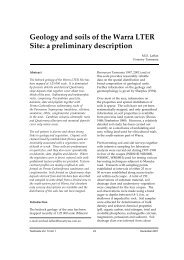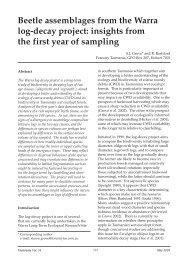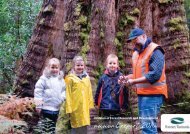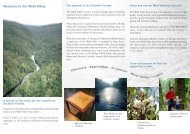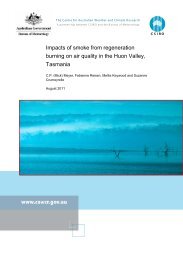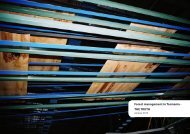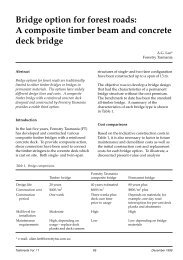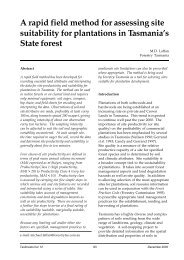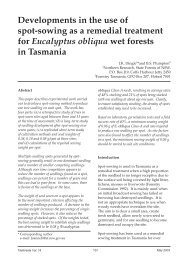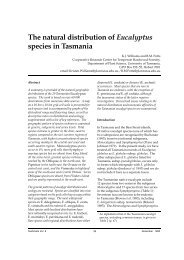sustainable forest management - Forestry Tasmania
sustainable forest management - Forestry Tasmania
sustainable forest management - Forestry Tasmania
You also want an ePaper? Increase the reach of your titles
YUMPU automatically turns print PDFs into web optimized ePapers that Google loves.
Seed and sowing<br />
<strong>Forestry</strong> <strong>Tasmania</strong> classifies the source of seed sown onto<br />
harvested native areas into three categories.<br />
On-site seed is collected from the harvested area or<br />
immediately adjacent to it from an area that has a similar<br />
topography, elevation, aspect, parent material and <strong>forest</strong><br />
type. On-site seed is highly desirable as it maintains gene<br />
pools and ensures that regeneration is well adapted to the<br />
site.<br />
In-zone seed is from the same seed zone as the nominated<br />
harvesting area. The seed zones are detailed in Native<br />
Forest Silviculture Technical Bulletin No. 1 Eucalypt Seed<br />
and Sowing. For the purposes of the performance indicator,<br />
in-zone seed does not include the on-site seed component.<br />
Out-of-zone seed is collected from outside the seed zone<br />
of the nominated coupe. This is the least preferred seed<br />
source. When there is insufficient on-site or in-zone seed,<br />
the most appropriate available out-of-zone seed is selected<br />
following the guidelines set out in Technical Bulletin 1.<br />
The seed provenance quality standard is that each<br />
harvested area should be regenerated with at least 10 per<br />
cent on-site seed with the remainder being in-zone seed<br />
matched to <strong>forest</strong> type. These seed provenance targets<br />
need to be met for each species in the sowing mix.<br />
In 2007/08, 3387 hectares was sown with eucalypt seed. A<br />
total of 1435 hectares (42 per cent) of this area achieved<br />
the seed provenance quality standard. This is a six per<br />
cent decrease when compared with the five-year average<br />
of 48 per cent of area achieving the standard (Figure 17).<br />
The main cause of not achieving the desired standard was<br />
insufficient on-site seed being available.<br />
In 2007/08, 2,912 kilograms of eucalypt seed was sown. Of<br />
that 31 per cent of the seed used was on-site, 62 per cent<br />
in-zone and seven per cent out-of-zone. This compares well<br />
with the five-year average of 40per cent on-site, 52 per cent<br />
in-zone and eight per cent out-of-zone seed.<br />
The quality standard for sowing operations is that the delay<br />
between site preparation completion and artificial sowing<br />
should be less than 21 days and shorter if possible. This is<br />
because the best regeneration generally occurs when seed<br />
is sown on the freshest and most receptive seedbed. In<br />
2007/08, 91per cent of the artificially sown area achieved<br />
this standard. This represented a five per cent decrease<br />
on the five-year average (96 per cent). The lack of available<br />
helicopters was the main reason for nine per cent of the<br />
100<br />
area not meeting the standard.<br />
90<br />
% of sown area meeting standard<br />
% of sown area meeting standard<br />
Figure 80 17. Five-year seed provenance performance by production area<br />
70<br />
60<br />
50<br />
40<br />
30<br />
20<br />
10<br />
0<br />
03/04 04/05 05/06 06/07 07/08<br />
2003/04 2004/05 2005/06 2006/07 2007/08<br />
27




